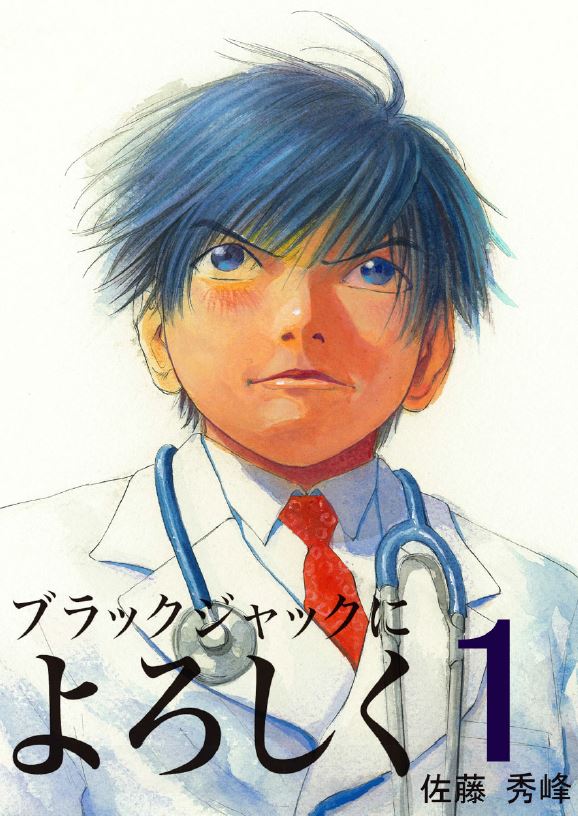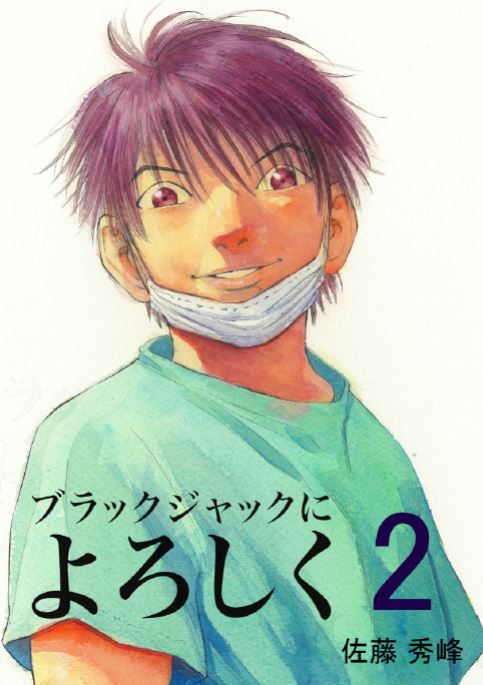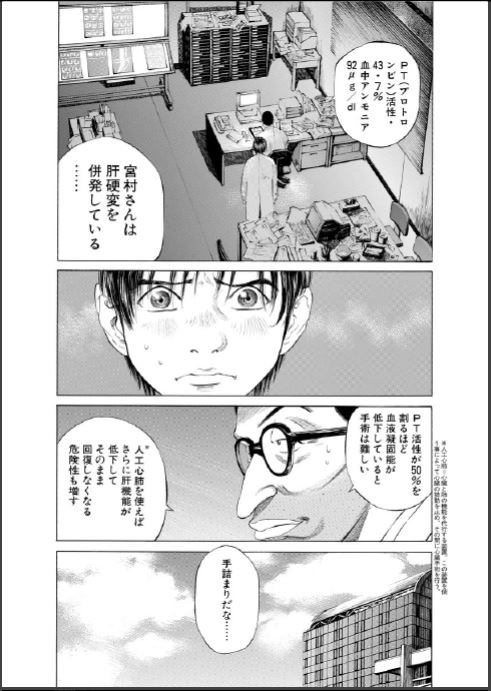*These Japanese lessons are created based on the Terms of Use of the Copyrights of them; TITLE: Give My Regards to Black Jack, AUTHOR: Shuho Sato, and WEBSITE: Manga on Web.
Japanese Lessons 2-1-1 告白 / The Confession
You can browse all of the pages by clicking the picture above and then move to any page via 「目次」 at the left. When you need English translations or explanations, please return here and refer them. This article covers from page 1 to page 22.
Japanese Script with Furigana and English Translation
「PT活性・43,7%、血中アンモニア92 μg/dl、宮村さんは肝硬変を併発している…。PT活性が50%を割るほど血液凝固能が低下していると手術は難しい。人工心肺を使えばさらに肝機能が低下して、そのまま回復しなくなる危険性も増す。手詰まりだな…。」
宮村さんの手術の成功率は極めて低い…!!
「昨日の心臓外科との会議の結果、宮村さんには冠状動脈バイパと手術は受けていただく事になりました。冠状動脈バイパス手術というのは…心臓の血管のつまってしまった部分に別の血管をつなぐ手術です。要するに、つまったパイプを別のパイプで迂回すると考えてください。バイパスには内胸動脈という胸の裏側にある血管を使います。手術の日程など…細かい事は追々*お話していきますので…。」
“Factor II activity 43.7%… blood ammonia 92 μg/dl. Mr. Miyamura has complicating hepatic cirrhosis. With factor II activity below 50%, his blood is less likely to clot. Surgery would be tricky. Using a heart-lung machine would further reduce his liver function. He may not be able to recover at all. We’re stuck.”
Mr. Miyamura’s chances for a successful surgery are almost nil.
“Mr. Miyamura, at yesterday’s meeting, with the cardiac surgery team, you were cleared for a coronary artery bypass. We can connect the blocked portion of your heart blood vessels to another free-flowing blood vessel. It’s like using a clean pipe to bypass a blocked pipe. The surgery uses the internal thoracic artery found at the rear of the chest cavity. We’ll keep you updated on scheduling and other details.”
One Point Lesson: Japanese Vocabulary
「々」 is actually not kanji. This is called 「踊り字 (lit. dancing character)」 and its function is to represent a duplicated character. For example, 人 means “person”, but once you attach 々, that becomes ひとびと and means “people”. For your information, 追々 can be translated as ”gradually”, “little by little”, and “step by step”.
「宮村さん…もうベッドの上に起きる気力もなくなったな。」「どうして本当の事を言っちゃいけないんですか…?」「医師法第23条に健康指導義務というのがある。医者は患者が不健康になる事をしてはいけないという法律だ。”不安”を与える事は心臓にとって好ましくない…。」「そんな…そんなのただの…」「こじつけだよ。本当の事を言って宮村さんが周囲に不満をもらしてでもみろ…、*万が一の時にこちらの立場が不利になるだけだよ。第一、真実を告げて何が変わる?結局オペは必要なんだ。仕事は山積みなんだ。余計な頭を使って仕事を遅らせるな…。」(思考を…停止させろって事ですか…?)
“Mr. Miyamura, he doesn’t even have the strength to sit up anymore.” “Why can’t we tell him the truth?” “Article 23 of the medical practitioners’ act: health guidance obligations. It says doctors must not cause ill health in their patients. And causing him anxiety would be bad for his heart.” “But… but that’s just..” “A real stretch. Go on, tell Mr. Miyamura how you really feel. You’ll only be weakening our position at a most critical time. How would telling the truth change things? He needs surgery, period. Look, I’m up to my neck in work. Give your mind a rest or I’ll fall behind.” (Is he telling me to stop thinking?)
[adsense]
One Point Lesson: Japanese Grammar
「…てみろ」 is the imperative-conditional form. The common usage is that you first show a condition and then tell a result, like this 「嘘をついてみろ、本気で怒るぞ ([if you] tell a lie, I will really get angry)」.
「おーい、そこの研修医ー。昨日の検査結果も温度板に書き写しておいてくれー。」「なあ斉藤、昼メシくった?*」「まだ…。」「出久根先生ー、担当患者さんのご家族が病状の説明をして欲しいそうでーす。」
“Hey! Intern! Add yesterday’s test results to the fever chart, would ja?” “Hey, Saito, you have breakfast yet?” “Not yet.” “Dr. Dekune! The patient’s family is asking for details about his condition.”
One Point Lesson: Japanese Expression
「食う」 is a Japanese slang and equivalent to 「食べる」. 「くった」 is the past form of 「食う」.
「そういや今日は戸田さんきてないのー。」「カゼひいて病院にこられんって言っとったわー。」
“Mr. Toda didn’t show up today, did he?” “Caught a cold, he said, and couldn’t come.”
(くそ…もうこんな時間か…。夕方の回診に行かなきゃ…。)
(Dammit… look at the time. I’ve got to get to my evening rounds.)
「斉藤~、晩メシ食いに行こーぜ~。」「ゴメン…まだ作業中。」「斉藤先生、明日退院する患者の書類を作っておいてくれ。」「おい、そこの*。弁当の買出しに行け。」
“C’mon, Saito– Let’s grab dinner.” “Sorry. I’m in the middle of this.” “Dr. Saito, I need a summary of the patients we’re discharging tomorrow.” “Hey, you there! Go on a takeout run.”
[adsense]
One Point Lesson: Japanese Expression
If you said 「そこの」 towards people, it would be very rude of you. This is basically used for non-animated things like 「そこの本 (The book over there)」.
(くそ…僕は一体なんなんだ…?僕は…なんのためにこんな事をしているんだ…?)
(Damn it all… What the hell am I, anyway? And why am I doing this?)
「あ…、あ…、あ…。」「もう一回行ってきて。自腹で。」
“No! Geez! Aw…” “Go get more. On your dime.”
(止まるな…止まるな…僕の思考…)
(Don’t stop. Don’t stop. Don’t stop. Thinking.)
「どうしても僕一人で行かなきゃいけませんか…?」「私は心臓外科に呼ばれている。たぶん宮村さんに関することだ。」「でも…」「子供みたいな事を言うな。朝夕の回診は君の義務だ。」
“Why do I have to go alone?” “The cardiac surgery team called me in. Might be something about Mr. Miyamura.” “But…” “Quit being so children. Morning and evening rounds are your responsibility.”
「失礼します…。」「やせましたね…。引き続きヘパリン点滴とニトロールの服用をお願いします。何かありましたら言ってください…。」「なあ…先生…。昔入院してたウチの親父が死んだときさ…病院の方からちゃんとした説明は何もなかったんだ。医者ってやっぱり怖いもんな。なんとなく何も訊けなかった…。気がついたら葬式が終わって、親父は骨になってたんだ…。もうすぐオレもそうなるんだな…」「本当は…今すぐに手術が必要なんです…手術が遅れているのは、病院側の勝手な都合です。宮村さんは肝硬変も悪化しているため、手術は非常に危険です…。はっきり申し上げて*、このままでは助かる見込みはほとんどありません…。僕も…どうしたらいいか分かりません…。ごめんなさい…。」
“Yes, sir.” “You’ve lost weight. I’d like you to stay on your heparin drip and keep taking nitorol. Let me know if anything comes up.” “Hey… Doc… Way back when my dad died in the hospital… They never really explained anything to us, you know. And doctors… doctors are scary. We couldn’t bring ourselves to ask them anything. Before I knew it, the funeral was over and my dad was nothing but bones. I’m headed down that road myself…” “Actually… You need surgery right away. The hospital is dragging its feet for its own selfish reasons. Your cirrhosis has worsened too, making surgery that much more dangerous… If I can speak frankly… there’s almost no likelihood of you surviving like this. And I… I don’t know what to do, either. I’m sorry.”
One Point Lesson: Japanese Expression
「はっきり申し上げて」 is 「はっきり申し上げる」 with the te-form and means “clearly speaking” or “frankly speaking”. This is a formal style, but you can express that casually using 「はっきり言って」.
「君は医者には向いていないな。」「だって…だって…。」「まあ、いいさ。どのみち君はもう宮村さんに近づけん…。* 明日、宮村さんは外科病棟に移る事に決まったよ…。君の役目は今日で終わりだ…。」
“You’re not cut out to be a doctor.” “I just… I just…” “It doesn’t matter. You won’t be dealing with Mr. Miyamura anymore. He’ll be transferred to the surgical ward tomorrow. Your work here today is done.”
One Point Lesson: Japanese Expression
「近づけん」 is a Japanese dialect and equivalent to 「近づけない (近づく with the negative-potential form)」. People who come from the west part of Japan sometimes use 「ん」 instead of 「ない」 like 「できない ⇒ できん」.
君の役目は今日で終わりだ。
(最低だ…何も出来ないくせに、宮村さんをただ不安に陥れた…。僕は…。)
Your work here today is done.
(This sucks… I riled up Mr. Miyamura — and for what? I ‘m power. I… )
「近こう寄れ。苦しゅうないぞ。」「ですから本当におやめ下さい!」「はっはっはー、ワシはじゃじゃ馬な女ほど燃えるんじゃー!」「ビンビンだぜイエー!」
“C’mon over! His majesty allows it!” “Enough already, please!” “Ha Ha Ha! You’re a fiery one… just the way I like em’. You really got me goin’, baby!”
「赤城さん…。」「あ、斉藤先生…。昨日はありがとう。おかげで助かったわ。もう帰るところ?あ、白衣着てるし違うか…。」「赤城さん…。」「ちょ…ちょっと…。」
“Ms. Akagi?” “Oh! Dr. Saito…” “Thanks again for yesterday. You really helped me out. Heading home? Oh, maybe not. You’re still in your whites.” “Ms. Akagi…” “Whoa! Er…”
「それで…?このまま自己嫌悪だけして、宮村さんとはお別れ…?」「だったらやる事は決まってるじゃない*!今すぐ宮村さんの退院手続きをとるの…。他のいい医者のいる病院に連れていくんだよ…!」
“Now what? You write off your patient and wallow in self-loathing?” “Then you know what you have to do! Get started on Mr. Miyamura’s discharge papers… You’ve got to take him somewhere with better doctors.”
One Point Lesson: Japanese Expression
「~じゃない」 is a Japanese sentence ending particle. The origin comes from a negative form like 「金持ちじゃない (I’m not rich)」. Today this has multiple meanings, but in this context this expresses a nuance of a reminder.
Recommended Links
Program Table of Japanese Lessons

Japanese Lessons: Learn Japanese Vocabulary with Manga 1-6-1

Japanese Lessons: Learn Japanese Grammar with Manga 2-2-1



